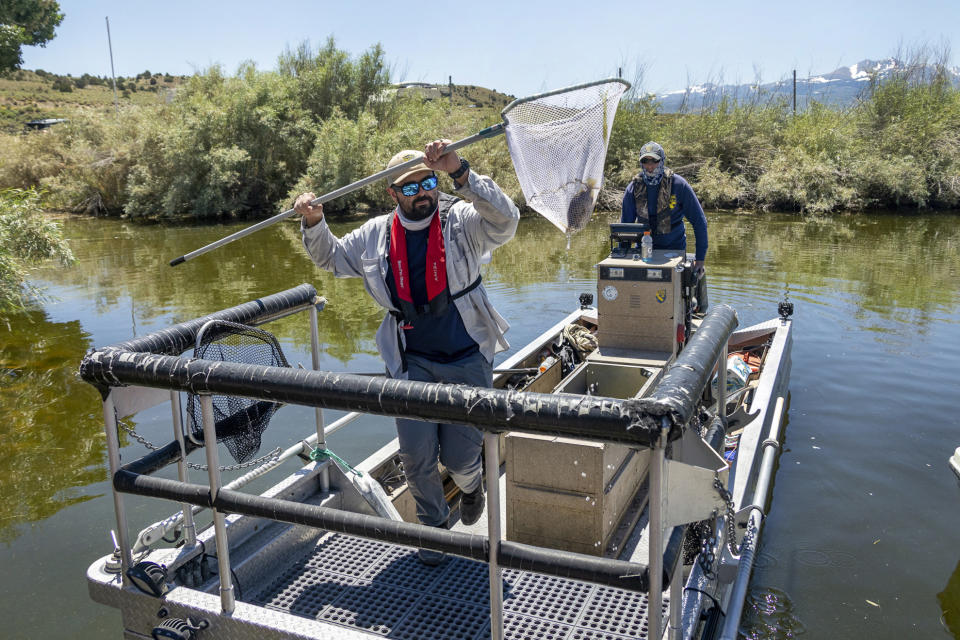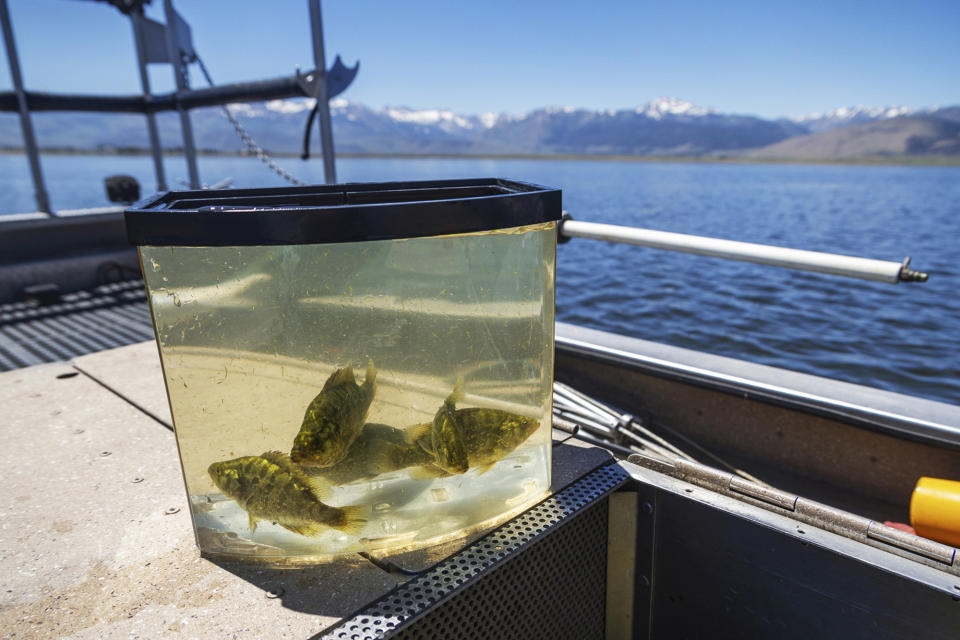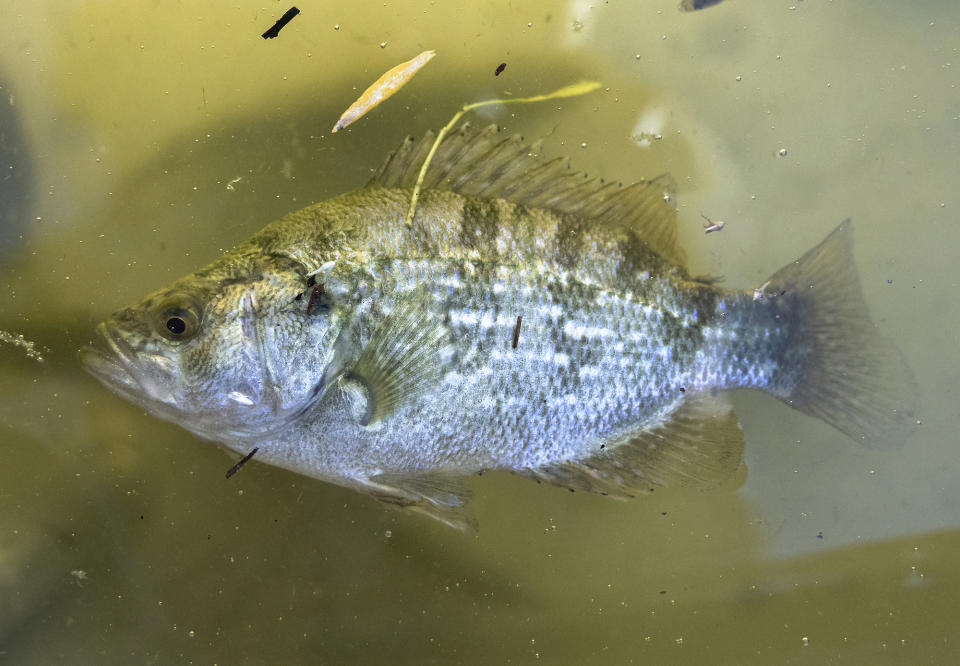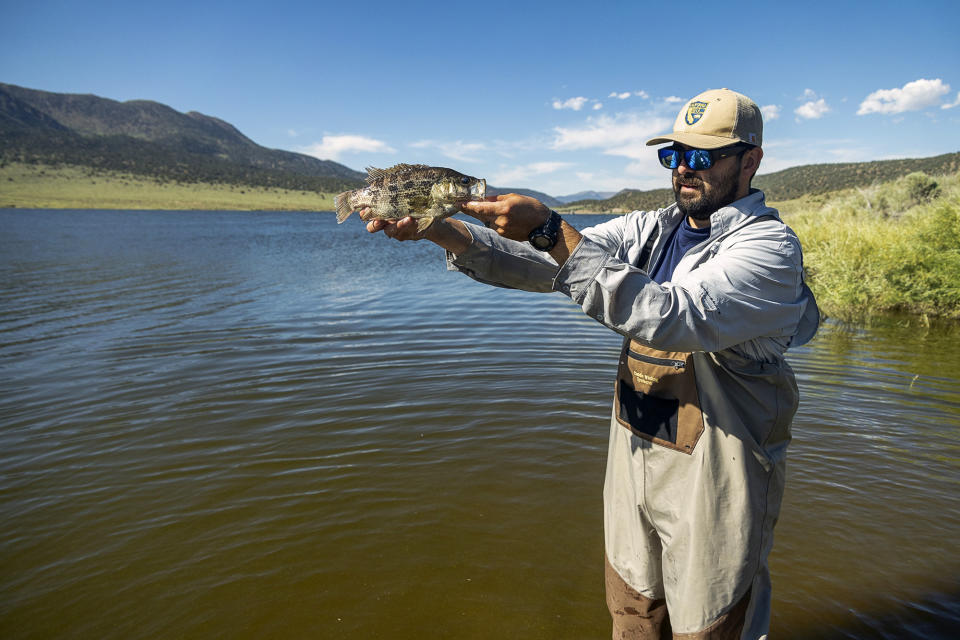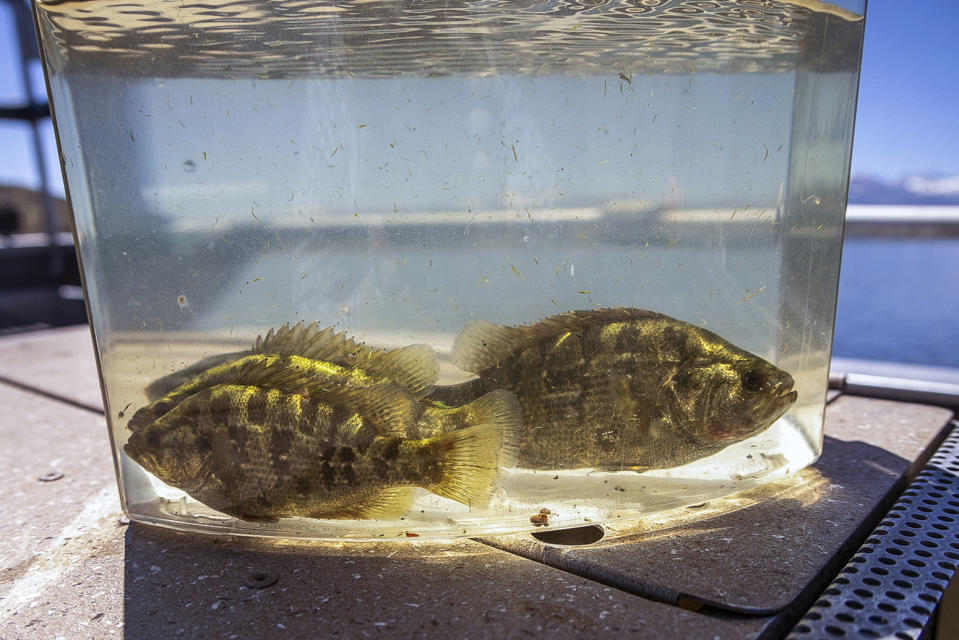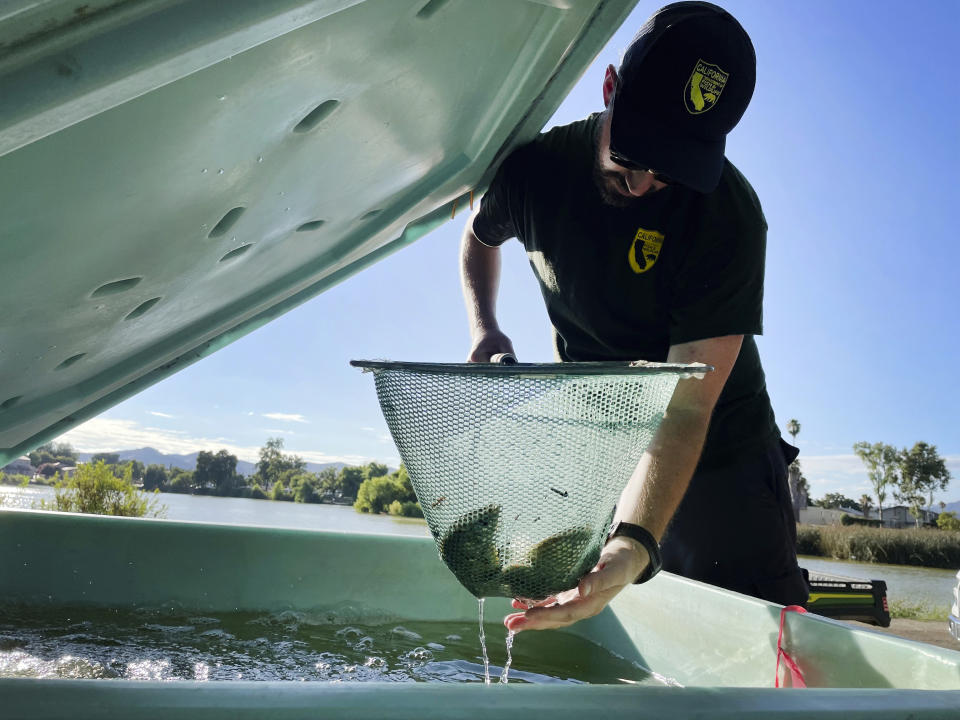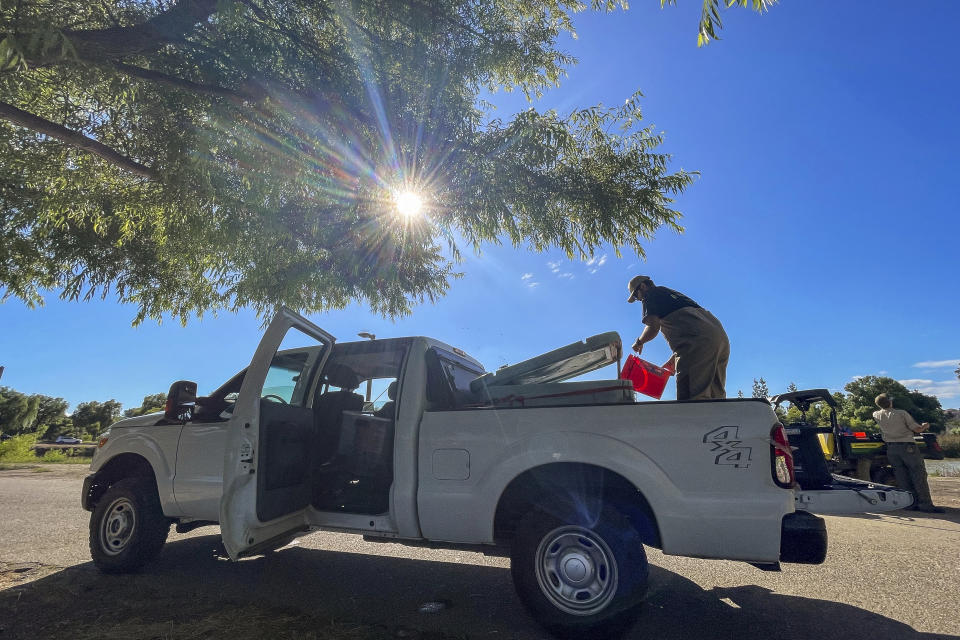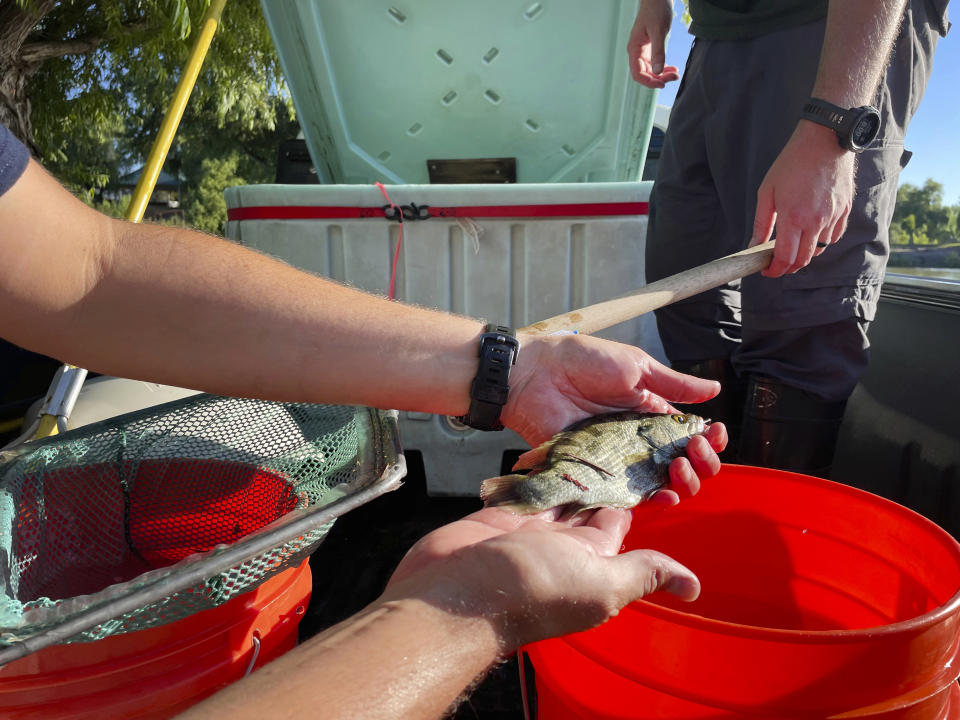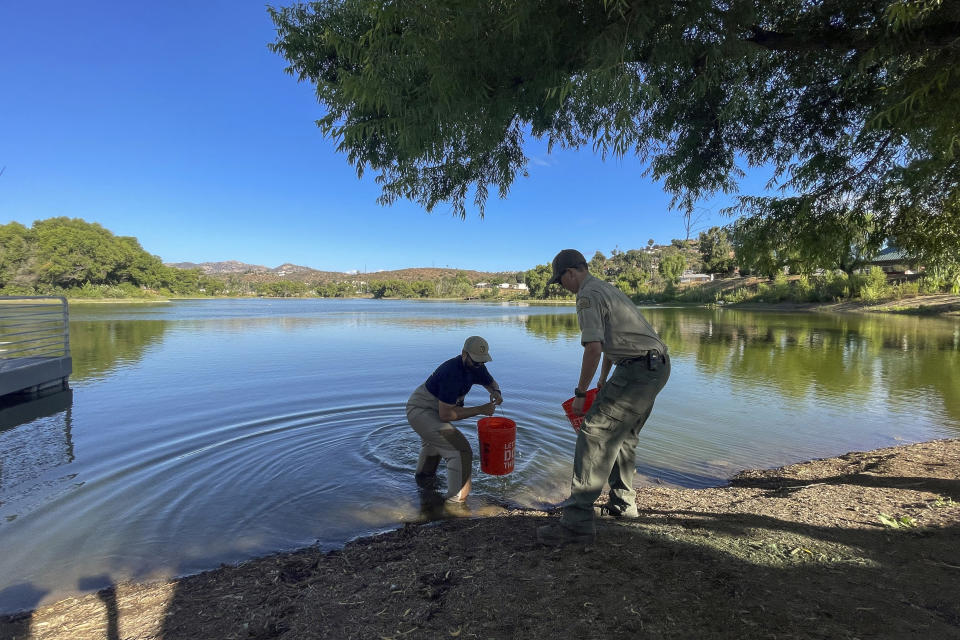California aims to introduce more anglers to native warm-water tolerant sunfish as planet heats up
SAN DIEGO (AP) — California’s only native sunfish, the Sacramento perch, survived catastrophic floods in the 1860s and was so abundant that it was a regular staple in San Francisco’s markets before invasive species decimated its population.
Today it is relegated to mostly isolated lakes, reservoirs and ponds with few predators. But as the planet heats up and threatens many cold-water game fish species like trout, the Sacramento perch may be on the cusp of a comeback, thanks in part to its ability to tolerate warm water and extreme conditions.
State officials recently introduced Sacramento perch to Southern California in an attempt to widen its range, strengthen its gene pool, create a breeding stock and generate interest among more anglers. Biologists with the California Department of Fish and Wildlife released the first batch of 37 mostly juvenile Sacramento perch on Thursday evening in San Diego County’s only natural lake, Lindo Lake in Lakeside, a suburb east of the city of San Diego.
“It’s a native game fish that we can promote as a viable fishery in the future where we may not be able to have trout in certain areas because of climate change and warming waters,” environmental scientist Matt Lucero with the department said after releasing the fish in batches.
The multiyear experiment reflects the changes facing sportfishing as rivers, streams, lakes and ponds warm. Climate change is the biggest threat to the survival of trout in America’s interior West, according to the Natural Resources Defense Council. It estimates up to 50% of trout habitat in the Rocky Mountain region is at risk of disappearing by the end of the century.
Sacramento perch will never replace trout, state biologists said. Instead, the focus is on preserving a native species, and as an added benefit, the fish could allow anglers another option as temperatures rise, limiting seasons for cold-water species in some places.
Max Fish, the department's senior environmental scientist overseeing the efforts, said the hope is it can be introduced to fishing spots in more urban areas.
“We're in an exploratory phase to evaluate how well the fish will do, and how communities react to those fisheries,” he said.
Tiffany Turner of the Theodore Roosevelt Conservation Partnership, which advocates for conservation to help anglers and hunters, said California is smart to act now to expand the habitat of climate-resilient fish, though she expects some resistance initially in a sport that is steeped in traditions.
“Anglers are going to have to adapt if we want to keep doing what we love," she said.
Biologists say the iridescent green and purple fish, whose markings and long spiny dorsal fins hint at its legacy dating back 15 million years, stands out for its ability to thrive in everything from cold mountain lakes to warm stagnant, brackish water.
Sacramento perch's resiliency allowed it to survive the catastrophic floods that wiped out much of Central California more than 160 years ago.
But its numbers plummeted by the early 20th century with the introduction of non-native species, including other more aggressive sunfish from the midwestern United States, which pushed the Sacramento perch out of its native habitat in the Sacramento-San Joaquin River Delta.
It's unknown if any still exist in its native habitat. Most of the population is concentrated in more than two dozen high-altitude lakes in Northern California, and a handful of western states.
Scientists hope that by introducing it to Southern California it will help strengthen the gene pool and build data for the captive breeding of Sacramento perch. Some hope the native fish can someday flourish as a food source much like tilapia, a highly adaptable warm-water species that is illegal to produce in California due to its potential to invade native ecosystems.
Peter Moyle, a Sacramento perch expert at the University of California, Davis, applauds the state for bringing it to Southern California. “It's one of the best tasting freshwater fish I know of,” he said, adding that it's also fun to fish since it puts up a fight.
Lucero said the project will take at least three years, and it'll be awhile before fishing even opens at Lindo Lake. There are still many challenges to overcome.
Last summer biologists released Sacramento perch larval in Lindo Lake after it was drained, dredged and restored to its natural state and outfitted with fish habitat structures. But someone since then dumped in a bucket of largemouth bass, which eat native sunfish eggs, Lucero said.
Biologists still don’t know how many have survived. They hope the introduction of juveniles will give the population a fighting chance of establishing itself. The juveniles are believed to be a year old and are expected to be able to spawn in another year, and lay as many as 10,000 eggs, Lucero said.
San Diego County officials have posted “No fishing” signs around Lindo Lake. Rangers also patrol regularly during daylight hours but it is a public park surrounded by apartment buildings, stores and modest ranch style homes.
Officials say the best assurance is educating people about how special the Sacramento perch is.
Lucero brought the Sacramento perch from Bridgeport reservoir, nestled in the jagged snow-capped Sierra Nevada mountains. Biologists identified it as a gene bottleneck for the species.
Lucero, with other state biologists, stunned the perch with an electrical current so they would float to the surface belly up to be able to scoop them up. They eventually loaded 37 young fish into a bin in the bed of a pickup truck, and Lucero drove them eight hours to the lake in San Diego County.
After arriving with the fish, Lucero spent an hour acclimating them to their new home, which is 6,000 feet (1,828 meters) lower in elevation. He slowly poured into their bin Lindo Lake water, which was at 83 degrees Fahrenheit (28.3 Celsius), while swapping out the water from Bridgeport, which was at 68 degrees Fahrenheit, (20 degrees Celsius).
The fish huddled together in a corner of the bin. Then they slowly spread out and swam around as the hour passed, which Lucero saw as a sign that they were ready to be released.
He eyed the lake. He said he did not want to release them too close to the dock where some of the bass might be waiting. But he said too far out in the center there were cormorants. A heron also watched nearby.
Lucero put on his waders and went in up to his waist.
Fellow environmental scientist Austin Sturkie, who is also with the department, stood on the dock and scooped out batch after batch of the fish as the sun began to dip and handed the net to Lucero in the water.
The fish wiggled out and swam away.
“Boys stay together,” Lucero joked.
As Lucero worked, a man on a skateboard zipped by and yelled “Yay! More bass.”
“No, it's Sacramento perch," Lucero shot back, smiling. "They're better!”

 雅虎香港新聞
雅虎香港新聞 
